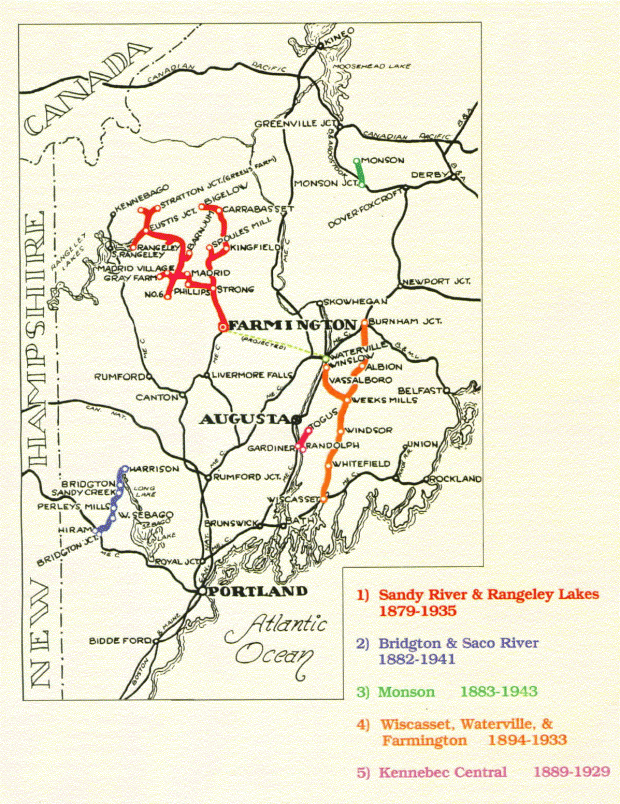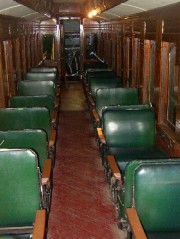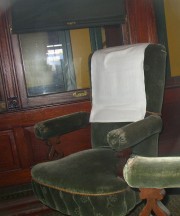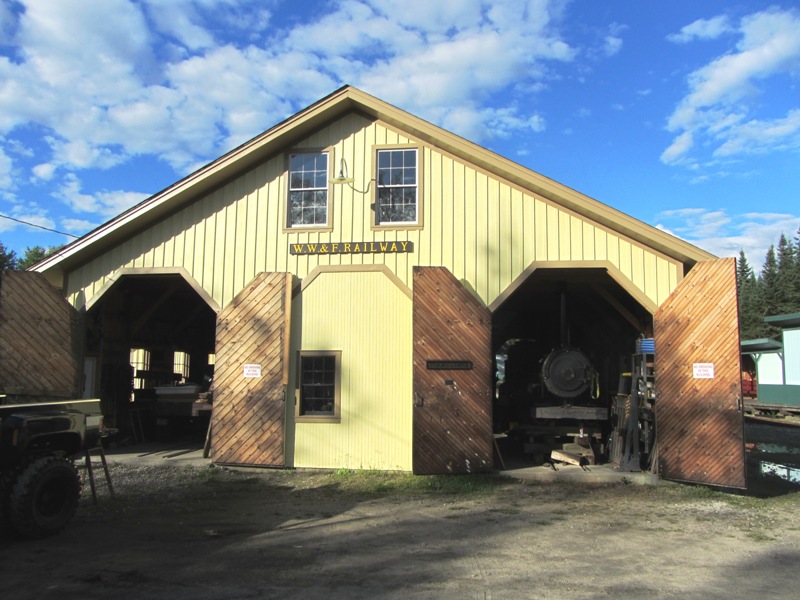Starting in the latter part of the 19th century, Maine had a unique system of railroads that ran on rails only two feet apart. Eventually five of these railroads served rural areas in western and central Maine.
They were the Sandy River & Rangeley Lakes , the Bridgton & Saco River (later the Bridgton & Harrison), the Monson, the Kennebec Central, and the Wiscasset & Quebec.
The idea of a two foot railroad developed after George Mansfield of Massachusetts visited Wales in the 1870’s and saw the Ffestiniog Railroad (which was actually only 23 1/2 inches wide). According to the unofficial site of the Ffestiniog Railway,
The Maine Narrow Gauge Railroad Co. & Museum in Portland maintains railroad equipment of this era.
The 1901 “Rangeley” was the first two-foot parlor car ever built. It served the Phillips & Rangeley Railroad for deluxe travel between Farmington and Rangeley, and later the Sandy River and Rangeley Lakes Railroad.
Passengers take short excursions in the refitted caboose.
Now, one of the top ten tourist attractions in Wales, it was originally built to carry slate from the quarries at Blaenau Ffestiniog to the harbour at Porthmadog. It used horses to pull empty wagons uphill and loaded trains ran by gravity over a superbly surveyed route high on the side of the Valley . . . . In 1863 steam locomotives were introduced, the first for regular traffic on a gauge as narrow as 2ft, copied from the lines already in use in the quarries. The railway began its first legal passenger service in 1865, becoming the world’s first narrow-gauge public railway. In 1869 it introduced the Fairlie articulated steam locomotive and in a series of trials held in 1869/70 attracted worldwide attention, having an influence on the course of railway development in many countries.1
In 1875 Mansfield established the Billerica & Bedford Railroad in Massachusetts, the first commercial two-footer in America . When the people in Franklin County wanted a railroad, Mansfield’s two-footer seemed ideal. The narrow gauge and smaller trains were less expensive to construct and easier to run through rough terrain.
When the Billerica & Bedford failed, the railroad equipment and Mansfield made the trip to Maine, where he organized the Sandy River & Rangeley Lakes (SR&RL) railroad in 1879. The largest of the railroads, the SR&RL ran from Farmington, where it interchanged with the standard gauge Maine Central, to Strong, Phillips, and Rangeley. Branch Lines included the Franklin & Megantic, the Phillips & Rangeley, and the Kingfield & Dead River .
The SR&RL carried both passengers and freight. It was a big railroad close to those of standard gauge trains. Operations ceased in 1935.
The Bridgton & Saco River Railroad (B&SR) was chartered in 1881. Construction was started in Hiram at the standard gauge in July 1882. George Mansfield also had a hand in the B&SR. He built the 16 mile road in six months, and in 1889 the road was extended five miles to Harrison. In 1912, the railroad was taken over by the Maine Central. In 1928, the Bridgton & Harrison Railway Company bought the B&SR, but business had been falling off so the line between Bridgton and Harrison was discontinued. In the 1930’s the “railfan” movement (people interested in restoring old railroads and retaining existing ones) and special excursions kept the railroad going. The last train ran in September 1941.
The third of the two-footers was the Monson Railroad, also known as “two by six,” because it was only six miles long. The Monson railway was a slate hauler and ran from the quarry near Monson to Monson Junction.
The guiding hand in the Monson line was H. E. Morrill, Superintendent of the Railroad. He retired in 1938 and the road did not last long after that, being abandoned in 1943.
But fortunately for railfans everywhere, two of the Monson’s engines, #3 and #4, were saved from scrappers. Both engines are now in Portland .
The fourth of the two-footers, the Kennebec Central, was built solely to serve the National Soldiers’ Home, Togus, in Chelsea. The line was open to traffic in 1890 and carried visitors to and from the Home and what is now Randolph on the Kennebec River. Special events such as weekly band concerts and popular baseball games, kept the line busy. Freight was chiefly coal. While passenger service flourished until the road’s demise in 1929, the advent of trucks hauling coal brought an end to the line.
The charter of the Wiscasset & Quebec (later the Wiscasset, Waterville & Farmington- WW&F) was dated 1854. However no gauge had been determined and construction was not begun until 1894. The intention was to ship commerce from Boston and New York to the Province of Quebec. For the first 20 miles, the line followed the Sheepscot River to Cooper’s Mills, going through Alna, Head Tide, North Whitefield. From Cooper’s Mills, the train went on to Week’s Mills and reached Albion in 1895, a run of 43 1/2 miles. In 1902, the Week’s Mills to Winslow line was completed. Textiles in North Vassalboro provided freight for the line. Milk, cattle, grain and general merchandise were also hauled along with a passenger service.
In 1906, the WW&F was sold to Carson Peck, a department store baron. In1912 the line was cut back from Winslow to North Vassalboro. The line was sold to local businessmen in 1926, with Sam Sewall as manager.
Like the other two-footers, the WW&F fell on hard times, and on June 15th, 1933 the end came. The train had left Whitefield and was heading to Wiscasset. On a curve approaching the Iron Bridge, the outside rail broke and the train went down a steep bank into the river. A year later, the wreck was still there, but vandals had stripped the engine. Eventually the remains were scrapped.
The WW&F Railroad Museum in Alna has restored and replicated elements of the railroad. It has a repair and restoration facility, several miles of track, and offers tours and rides to visitors.
Standard gauge railroads in the United States, the United Kingdom of are 56 inches wide. While most of Maine’s narrow gauge railroads were 24 inches, in other states 36 inches or some other variation are considered “narrow gauge.”
Adapted from “Two Foot Tips,” a publication of the Maine Narrow Gauge Railroad Co. & Museum, Portland, Maine.
Additional resources
Barney, Peter S. The Bridgton and Saco River: A Technical and Pictorial Review. Kennesaw, Ga. A & M Publishing. South Dartmouth, Mass. Distributed by Sandy River Car Shops. 1987.
Barney, Peter S. Handcars, Railcars, and Railbuses of the Sandy River & Rangeley Lakes R.R. Maine? A&M Pub.1990.
Jones, Robert C. Two Feet to the Lakes: the Bridgton & Saco River Railroad. Edmonds, Wash. Pacific Fast Mail. c1993.
Maine Narrow Gauge Railroad Co. & Museum, Portland, Maine.
McChesney, Chris. Narrow Gauge in the Sheepscot Valley: A Comprehensive Guide to the Wiscasset, Waterville & Farmington Railway. Washingtonville, OH. M2FQ Publications, 2001-2003.
Moody, Linwood W. The Maine Two-footers: The Story of the Two-foot Gauge Railroads of Maine. Berkeley, Ca. Howell-North. 1959.
Walker, Ellis. Wiscasset, Waterville & Farmington Musings: A Collection . . . . Alna, Me. Wiscasset, Waterville & Farmington Railway Museum, 2003.
“What are the ‘Maine Two Footers’?” http://maineon2faq.wordpress.com/2013/08/11/what-are-the-maine-two-footers/ (accessed February 1, 2014)
Wiggin, Ruby Crosby. Albion on the Narrow Gauge. Clinton, Me.? 1964.
1 http://www.ffestiniog.cwc.net/page2.html. Accessed May 29, 2005.










Would have loved to live during that era. The narrow gauge ran across my parents property on Pond Rd in Bridgton, ME. When I was growing up the tracks had already been pulled up, but a bridge was still there.